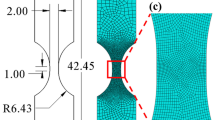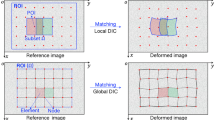Abstract
Recently, the issue of automatically defining virtual fields for non-linear constitutive models has been resolved (Marek et al., Comput Mech 60:409–431, 2017), relying on a new sensitivity-based approach hereby reducing the influence of noise on the parameter identification. These new set of fields act as weighting factors in the identification process emphasizing the impact of measurement regions with high signal to noise ratios. Conclusions in (Marek et al., Comput Mech 60:409–431, 2017) were drawn based on a numerical example involving small strain plasticity. In this presentation, the performance of these newly defined fields is studied when applied to digital image correlation (DIC) measurement data, hereby including the DIC filtering effects through synthetic image deformation (Rossi et al., Strain 51:206–222, 2017). Results are presented for both large strain isotropic plasticity and hyperelastic material models.
Access provided by Autonomous University of Puebla. Download conference paper PDF
Similar content being viewed by others
Keywords
Theoretical Development
For a detailed theoretical development of the sensitivity-based VFs the user is referred to [1]. In summary, the idea behind the proposed approach is that these fields will emphasize regions that carry the most information about the involved constitutive parameters and their time evolution. Each model parameter i is perturbated in order to determine intrinsic parameter δσ(i)(ε, X, t) sensitivity and incremental sensitivity \( \delta {\overset{\sim }{\boldsymbol{\sigma}}}^{(i)}\left(\boldsymbol{\varepsilon}, \boldsymbol{X},t\right) \) maps, with X the vector of the model parameters and t the time step. The virtual displacement u∗ are then determined from these maps by imposing a virtual mesh on the data point cloud. Next, when the equations for every element in the mesh are collected the following system of equations is produced:
where B is the global strain-displacement matrix. It is important to stress that every parameter will come with its own sensitivity maps and accordingly will yield a different set of virtual fields.
Synthetic Images
The regularization properties (subset size, step, shape function, strain method etc.) of full-field measurements as DIC might have a substantial impact on the involved sensitivity maps and accordingly on the performance of the automatically-defined virtual fields. In order to study the impact of DIC filtering effects an identical methodology is adopted as outlined in [2] based on synthetic image deformation. Hereby, a virtual set of experimental images is created with benchmark input material parameters. The numerical deformed speckle images are created via MatchID’s finite element deformation module (http://www.matchid.eu), with image deformation expressed in the reference configuration based on the shape functions of the corresponding nodes and end up in integer pixel locations in the deformed image. This not only avoids extra interpolation steps but also guarantees that one naturally arrives at a Lagrangian prescription of the image deformation process [3]. These are then analysed by a DIC platform (http://www.matchid.eu) with a quantified set of user variables. Finally, seamlessly feeding the resulting strain fields into the VFM module (http://www.matchid.eu) allows material parameter extraction and validation with the known reference parameters.
Case Study
The method was tested using simulated Abaqus data from a uniaxial tensile test on a double-notched specimen as depicted in [1] and a specimen with a set of circular stress concentrations as in Fig. 23.1. Gaussian noise with a standard deviation of 0.7% was artificially added to the simulated strain data to simulate typical noise levels during an actual experiment. It is important to stress that in contrast to [1], a large strain formulation has been adopted with corresponding stress fields expressed in the first Piola-Kirchoff convention allowing the VFM to apply boundary conditions in the reference configuration.
The applied DIC settings and retrieved strain resolution are summarized in Table 23.1. Additionally, MatchID’s missing data compensation technique has been imposed in order to retrieve data up to the edges of the specimen, hereby relying on the subset shape functions.
Table 23.2 contains the results of a basic isotropic Von Mises plasticity model adopting linear hardening, and a hyperelastic first-order Mooney-Rivlin model. The conference presentation will encompass a more broad variety of non-linear model results. It can be depicted from both tables that the sensitivity-based virtual fields outperform the uniform defined ones, reproducing the input parameters with high accuracy despite the involved DIC filtering effects.
Impact of DIC Filtering
In order to study the impact of the main DIC regularization parameters (subset, step and strain window) on the final identified properties, a performance analysis was undertaken for the hyperelastic case study. Hereby, various combinations of the abovementioned DIC parameters corresponding to different virtual strain gauge values generated an averaged identification error plot displayed in Fig. 23.2. As can be depicted, the sensitivity-based VF are more dominantly depending on the spatial resolution of DIC compared to the uniform ones. This is due to the fact that they rely on local gradient variations in determining the incremental gradient maps. However, an asymptotic accurate identification trend can be derived towards smaller VSGs. The uniform VF depend less on the VSG size, resulting in a general total error of approximately 10%.
Conclusion
Sensitivity-based virtual fields act as a weighting factor in the parameter identification process. It is clearly illustrated that these fields outperform their uniform counterparts. Moreover, this method allows to reproduce input parameters with high accuracy despite the involved DIC filtering effects if a DIC convergence study is made. The adopted method is computationally very efficient and does not require a non-straightforward coupling to finite element solvers as in inverse model updating schemes. In the future, more complicated material models will be investigated, as e.g. the calibration of a non-linear viscoplastic three-network-model [4].
References
A. Marek, F. Davis, F. Pierron, Sensitivity-based virtual fields for the non-linear virtual fields method. Comput. Mech. 60, 409–431 (2017)
M. Rossi, P. Lava, F. Pierron, D. Debruyne, M. Sasso, Effect of DIC spatial resolution, noise, and interpolation error on identification results with the VFM. Strain 51, 206–222 (2017)
P.L. Reu et al., DIC challenge: developing images and guidelines for evaluating accuracy and resolution of 2D analyses. Exp. Mech. 58(9), 1067–1099 (2018)
J. Bergstrom, An advanced thermomechanical constitutive model for UHMWPE. Int. J. Struct. Chang. Solids 2(1), 31–39 (2010)
Author information
Authors and Affiliations
Corresponding author
Editor information
Editors and Affiliations
Rights and permissions
Copyright information
© 2020 Society for Experimental Mechanics, Inc.
About this paper
Cite this paper
Lava, P., Furmanski, J., Marek, A., Davis, F.M., Pierron, F. (2020). Evaluation of Sensitivity-Based Virtual Fields for Non-Linear Parameter Identification Including DIC Filtering Effects. In: Baldi, A., Kramer, S., Pierron, F., Considine, J., Bossuyt, S., Hoefnagels, J. (eds) Residual Stress, Thermomechanics & Infrared Imaging and Inverse Problems, Volume 6. Conference Proceedings of the Society for Experimental Mechanics Series. Springer, Cham. https://doi.org/10.1007/978-3-030-30098-2_23
Download citation
DOI: https://doi.org/10.1007/978-3-030-30098-2_23
Published:
Publisher Name: Springer, Cham
Print ISBN: 978-3-030-30097-5
Online ISBN: 978-3-030-30098-2
eBook Packages: EngineeringEngineering (R0)






